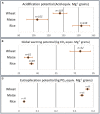Coupling the environmental impacts of reactive nitrogen losses and yield responses of staple crops in China
- PMID: 36092406
- PMCID: PMC9450997
- DOI: 10.3389/fpls.2022.927935
Coupling the environmental impacts of reactive nitrogen losses and yield responses of staple crops in China
Abstract
Cropland reactive nitrogen losses (Nr) are of the greatest challenges facing sustainable agricultural intensification to meet the increases in food demand. The environmental impacts of Nr losses and their yield responses to the mitigation strategies were not completely evaluated. We assessed the environmental impacts of Nr losses in China and coupled the efficiency of mitigation actions with yield responses. Datasets about Nr losses in China were collected, converted into potentials of acidification (AP), global warming (GWP), and aquatic eutrophication (AEP), and analyzed by a meta-analysis program. Results showed that producing 1 Mg of rice grains had the highest AP (153 kg acid equiv.), while wheat had the highest GWP and AEP (74 kg CO2 equiv. and 0.37 kg PO4 equiv., respectively). Using the conventional rates (averagely, 200, 230, and 215 kg N ha-1) of urea as a surface application to produce 131.4, 257.2, and 212.1 Tg of wheat, maize, and rice resulted in 17-33 Tg, 7-10 Tg, and 6-87 Gg of AP, GWP, and AEP, respectively. For their balanced effect on reducing AP, GWP, and AEP while maximizing yields, inhibitors, and subsurface application could be set as the best mitigation strategies in wheat production. Inhibitors usage and biochar are strongly recommended strategies for sustainable production of maize. None of the investigated strategies had a balanced effect on rice yield and the environment, thus new mitigation technologies should be developed.
Keywords: acidification; aquatic eutrophication; global warming; meta-analysis; mitigation strategies; nitrogen fertilizer.
Copyright © 2022 Abdo, Sun, Li, Yang, Metwally, Abdel-Hamed, Wei and Zhang.
Conflict of interest statement
The authors declare that the research was conducted in the absence of any commercial or financial relationships that could be construed as a potential conflict of interest.
Figures






Similar articles
-
Maintaining higher grain production with less reactive nitrogen losses in China: A meta-analysis study.J Environ Manage. 2022 Nov 15;322:116018. doi: 10.1016/j.jenvman.2022.116018. Epub 2022 Sep 5. J Environ Manage. 2022. PMID: 36067673
-
Integrating life cycle assessment and a farmer survey of management practices to study environmental impacts of peach production in Beijing, China.Environ Sci Pollut Res Int. 2022 Aug;29(38):57190-57203. doi: 10.1007/s11356-022-19780-0. Epub 2022 Mar 28. Environ Sci Pollut Res Int. 2022. PMID: 35344146
-
Data-driven estimates of fertilizer-induced soil NH3 , NO and N2 O emissions from croplands in China and their climate change impacts.Glob Chang Biol. 2022 Feb;28(3):1008-1022. doi: 10.1111/gcb.15975. Epub 2021 Nov 17. Glob Chang Biol. 2022. PMID: 34738298
-
Optimizing rice yields while minimizing yield-scaled global warming potential.Glob Chang Biol. 2014 May;20(5):1382-93. doi: 10.1111/gcb.12413. Epub 2014 Feb 24. Glob Chang Biol. 2014. PMID: 24115565 Review.
-
Eco-friendly yield-scaled global warming potential assists to determine the right rate of nitrogen in rice system: A systematic literature review.Environ Pollut. 2021 Feb 15;271:116386. doi: 10.1016/j.envpol.2020.116386. Epub 2020 Dec 24. Environ Pollut. 2021. PMID: 33388675
Cited by
-
Growth and yield of maize in response to reduced fertilizer application and its impacts on population dynamics and community biodiversity of insects and soil microbes.Front Plant Sci. 2024 May 24;15:1362905. doi: 10.3389/fpls.2024.1362905. eCollection 2024. Front Plant Sci. 2024. PMID: 38855460 Free PMC article.
-
Nitrogen use efficiency in bread wheat: Genetic variation and prospects for improvement.PLoS One. 2024 Apr 10;19(4):e0294755. doi: 10.1371/journal.pone.0294755. eCollection 2024. PLoS One. 2024. PMID: 38598487 Free PMC article.
References
-
- Abdo A. I., Shi D., Li J., Yang T., Wang L. (2020). Ammonia emission from staple crops in China as response to mitigation strategies and agronomic conditions: meta-analytic study. J. Cleaner Produc. 279:123835. 10.1016/j.jclepro.2020.123835 - DOI
-
- Barnard R., Leadley P. W., Hungate B. A. (2005). Global change, nitrification, and denitrification: a review. Global Biogeochem Cycles 19, 1–13. 10.1029/2004GB002282 - DOI
-
- Borenstein M., Hedges L. V., Higgins J. P. T., Rothstein H. R. (2009). Comprehensive Meta Analysis (Version 2.2.064). Englewood, NJ: Biostat.
Publication types
LinkOut - more resources
Full Text Sources
Research Materials
Miscellaneous

